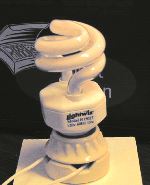Fluorescent Lights
An incandescent light bulb is not very efficient. 90% of the electrical energy going into it comes
out in the form of heat or invisible infrared light. Fluorescent lights are much better in this respect.
 However, they require special electrical circuitry to get them going and keep them on; and for reasons
having to do with how they work, they are more naturally made in the form of long tubes. Conversion from incandescent to fluorescent lighting seemed to require a substantial commitment, and as a result household lighting is still largely based on incandescent lighting.
However, they require special electrical circuitry to get them going and keep them on; and for reasons
having to do with how they work, they are more naturally made in the form of long tubes. Conversion from incandescent to fluorescent lighting seemed to require a substantial commitment, and as a result household lighting is still largely based on incandescent lighting.
In order to resolve these problems and make electrical use more efficient, the fluorescent
light was redesigned, to make it compact with a screw-in base and electronic
adaptor that allows it to be used in incandescent fixtures.
It's still a tube, but rolled up into a ball!
All fluorescent lights contain mercury discharge light sources. Electrical current passing
through a low pressure gas containing mercury vapor excites the mercury atoms;
they then emit the characteristic mercury spectrum.

Lights having this spectrum sometimes are used for outdoor lighting, but
they give poor color rendition because the spectrum doesn't contain any
red light. They also are not as efficient as they
could be, this time because they are emitting too much ultraviolet light. These defects can be
remedied by including other chemicals in the discharge or by using chemicals
(called phosphors) that absorb the ultraviolet light and emit visible light.
There are several different techologies of this sort (discussed at
the spectrum page), including the fluorescent
light.
Fluorescent lights have
been in use for over fifty years. These are usually in the form of tubes, and have a spectrum
consisting of a continuum (from the phosphor) with the green and violet mercury lines peeking
through.

This photograph exaggerates the lines, and doesn't
represent the colors of the continuum very well.
However, about the time of the development of the compact fluorescent light, more efficient
phosphors were formulated; and so these were incorporated in the compact fluorescent light.
The spectrum of this phosphor consists of several narrow bands: violet,
green, and faint orange-yellow from mercury, and red and blue-green contributed
by the phosphor.

Use of this phosphor is not restricted to the compact fluorescent light;
it is also available in the conventional tubular form.
However, these require a rewiring of the power regulator in the fluorescent light
fixture to achieve maximum efficiency, and so the traditional fluorescent spectrum will be with
us for a few years more. New buildings will surely use the new spectrum, and the old spectrum
lights will be replaced in building renovations.
A compact fluorescent light costs about ten times as much as an incandescent bulb ($8 instead
$0.80). However, it lasts 8 times as long (8000 hours vs. 1000 hours), so the bulb costs are actually
about the same. In 1000 hours of use, a 75 Watt incandescent light bulb will use $7.50 worth of
electricity (assuming electricity costs $0.10 per kilowatt hour), while the corresponding compact
fluorescent will cost only $1.50 to operate.
 A compact fluorescent light, photographed through a diffraction grating
A compact fluorescent light, photographed through a diffraction grating
 However, they require special electrical circuitry to get them going and keep them on; and for reasons
having to do with how they work, they are more naturally made in the form of long tubes. Conversion from incandescent to fluorescent lighting seemed to require a substantial commitment, and as a result household lighting is still largely based on incandescent lighting.
However, they require special electrical circuitry to get them going and keep them on; and for reasons
having to do with how they work, they are more naturally made in the form of long tubes. Conversion from incandescent to fluorescent lighting seemed to require a substantial commitment, and as a result household lighting is still largely based on incandescent lighting.



 A compact fluorescent light, photographed through a diffraction grating
A compact fluorescent light, photographed through a diffraction grating